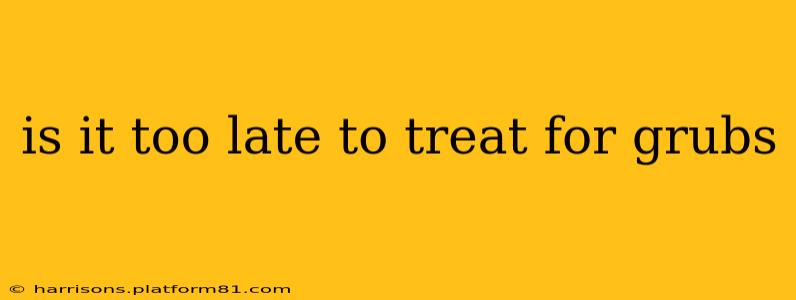Is It Too Late to Treat for Grubs? A Comprehensive Guide to Grub Control
Dealing with a grub infestation in your lawn can be frustrating. The telltale signs – patchy, brown grass, easily lifted turf – are enough to make any homeowner worry. But the crucial question many ask is: is it too late to treat for grubs? The answer, thankfully, isn't a simple yes or no. Timing is key, but there's still hope even if you think you've missed the ideal window.
This guide will help you understand the best time to treat for grubs, what factors influence treatment effectiveness, and what options remain even if you're dealing with a late-season infestation.
What are the best times to treat for grubs?
The optimal time to treat for grubs depends heavily on your geographic location and the specific type of grub infesting your lawn. Generally, early detection and preventative treatments are most effective. However, many grubs are active in the late summer and early fall, making late-season treatment a possibility. Monitoring for grub activity throughout the growing season is essential for timely intervention.
What are the signs of a grub infestation?
Recognizing the signs of a grub infestation early is crucial for effective treatment. Look for:
- Patchy brown or yellowing grass: This is often the first noticeable sign.
- Easily lifted turf: The grass pulls away from the soil easily, almost like a rug.
- Adult beetles: Depending on the type of grub, you may see adult beetles (like Japanese beetles) in the lawn.
- Birds digging in your lawn: Birds are attracted to grubs as a food source.
What factors influence the effectiveness of grub treatment?
Several factors play a role in how effective a grub treatment will be, even if applied later in the season:
- Grub life cycle stage: If the grubs are in their later stages of development, treatment might be less effective.
- Soil temperature and moisture: Optimal soil conditions are essential for the insecticide to work properly.
- Type of insecticide used: Different insecticides have different efficacy and application methods. Some are preventative, while others work better on actively feeding grubs.
- Thorough application: Inconsistent application can leave areas untreated, allowing the grubs to survive.
Can I still treat for grubs late in the season?
Yes, it might still be possible to treat for grubs even if it’s late in the season. While early preventative treatments are generally recommended, late-season treatments can still offer some level of control, especially if the infestation is not severe. The effectiveness will depend on the factors mentioned above. You might need to consider a different treatment strategy depending on your situation.
What are the different types of grub treatments available?
Several types of grub treatments are available, including:
- Insecticides: These are available as granular, liquid, or systemic options. They're applied directly to the lawn.
- Beneficial nematodes: These microscopic worms are natural predators of grubs and provide a more environmentally friendly control method.
- Cultural controls: These involve practices like proper lawn care to improve the health of your grass, making it more resistant to grub damage. This includes appropriate watering, fertilization, and aeration.
What should I do if I suspect a grub infestation?
If you suspect a grub infestation, take the following steps:
- Confirm the presence of grubs: Remove a small section of sod to check for grubs in the soil.
- Identify the type of grub: This will help determine the best treatment strategy.
- Choose a treatment method: Select a treatment based on the severity of the infestation, your preferences, and the time of year.
- Apply the treatment according to the product instructions: Pay close attention to application rates and safety precautions.
- Monitor your lawn: Observe your lawn after treatment to assess its effectiveness.
By carefully considering the timing, the severity of the infestation, and the type of grub involved, you can determine whether it's still worthwhile to treat for grubs, even if it seems late in the season. Remember that prevention is always better than cure, so healthy lawn practices are essential for minimizing future infestations.
